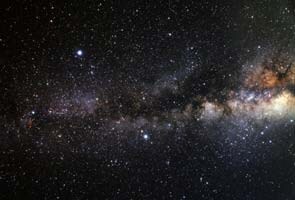
If the universe is not doomed by the top quark, it could face an even stranger fate - one dominated by so-called Boltzmann Brains - in which any random event, no matter how unlikely, could happen, given enough time
New York:
The universe may end in another 10 billion years or sooner if the heaviest of all the known elementary particles - the top quark - is even heavier than previously thought, scientists say.
The protons and neutrons that make up the nuclei of atoms are made of elementary particles known as quarks. Protons and neutrons are made up of the lightest and most stable flavours of quark: the up quark and down quark.
The heaviest and most unstable flavour of quark is the top quark, which current experiments suggest is about 184 times heavier than the proton.
Now, theoretical physicists have found that if the top quark is heavier than currently thought, the energy suffusing the vacuum of empty space may one day destabilise.
"If the vacuum destabilises, we would all die," said researcher Sean Carroll, a theoretical physicist at the California Institute of Technology, LiveScience reported.
First, microscopic bubbles would appear and affect the Higgs field, which pervades space and is responsible for the masses of particles such as electrons and quarks.
Those tiny bubbles in space, however, would cause the Higgs field to have lower energy than its current value.
"These bubbles appear only rarely, but when they do, they expand at close to the speed of light," Carroll said.
If such a bubble were to hit Earth, the masses of all the particles that depend on the Higgs field would suddenly change and no living creature would survive.
These bubbles may appear every 20 billion years or so. In comparison, the universe is about 13.8 billion years old, so the universe may have 10 billion years or so left to live.
If the universe is not doomed by the top quark, it could face an even stranger fate - one dominated by so-called Boltzmann Brains - in which any random event, no matter how unlikely, could happen, given enough time.
However, if the top quark is massive enough to potentially doom all life, then the energy of the vacuum would be low enough to avoid the concept of Boltzmann Brains.
"We're not arguing that Boltzmann Brains exist - we're trying to avoid them," Carroll said.
In order "to bring on rapid cosmic doomsday and avoid the Boltzmann Brain menace," the top quark's mass needs to be about 178 billion electron volts, corresponding to 188 times the mass of the proton, Carroll said.
This is about 3 per cent heavier than the top quark's current measured mass of 173 billion electron volts, "but there are uncertainties on that measurement, and the top quark could easily be a few billion electron volts heavier than we think," he added.
The protons and neutrons that make up the nuclei of atoms are made of elementary particles known as quarks. Protons and neutrons are made up of the lightest and most stable flavours of quark: the up quark and down quark.
The heaviest and most unstable flavour of quark is the top quark, which current experiments suggest is about 184 times heavier than the proton.
Now, theoretical physicists have found that if the top quark is heavier than currently thought, the energy suffusing the vacuum of empty space may one day destabilise.
"If the vacuum destabilises, we would all die," said researcher Sean Carroll, a theoretical physicist at the California Institute of Technology, LiveScience reported.
First, microscopic bubbles would appear and affect the Higgs field, which pervades space and is responsible for the masses of particles such as electrons and quarks.
Those tiny bubbles in space, however, would cause the Higgs field to have lower energy than its current value.
"These bubbles appear only rarely, but when they do, they expand at close to the speed of light," Carroll said.
If such a bubble were to hit Earth, the masses of all the particles that depend on the Higgs field would suddenly change and no living creature would survive.
These bubbles may appear every 20 billion years or so. In comparison, the universe is about 13.8 billion years old, so the universe may have 10 billion years or so left to live.
If the universe is not doomed by the top quark, it could face an even stranger fate - one dominated by so-called Boltzmann Brains - in which any random event, no matter how unlikely, could happen, given enough time.
However, if the top quark is massive enough to potentially doom all life, then the energy of the vacuum would be low enough to avoid the concept of Boltzmann Brains.
"We're not arguing that Boltzmann Brains exist - we're trying to avoid them," Carroll said.
In order "to bring on rapid cosmic doomsday and avoid the Boltzmann Brain menace," the top quark's mass needs to be about 178 billion electron volts, corresponding to 188 times the mass of the proton, Carroll said.
This is about 3 per cent heavier than the top quark's current measured mass of 173 billion electron volts, "but there are uncertainties on that measurement, and the top quark could easily be a few billion electron volts heavier than we think," he added.
Track Latest News Live on NDTV.com and get news updates from India and around the world

